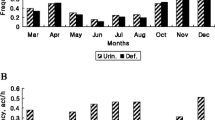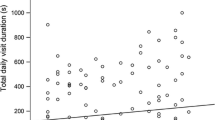Abstract
Urine marking behaviour was observed over 14 months in two captive pairs of Iberian wolves (Canis lupus signatus) by means of behaviour sampling. The study focused on the relative attractiveness of the different stimuli toward which urinations are directed, the seasonal context of urine marking, and the response by mates to sexually dimorphic action patterns. Kinds of marked substrates varied according to the posture used by wolves to urinate [raised-leg urination (RLU), flexed-leg urination (FLU), standing urination (STU), or squat urination (SQU)]. In RLUs and FLUs the wolves mainly used conspicuous substrates, whereas STUs and SQUs were carried out directly onto inconspicuous substrates. Wolves urinated on plants more than on other substrates, mostly selecting trees. A selection of trees according to their trunk diameter was also observed. The posts were chosen or avoided seemingly because of their specific characteristics such as size. In short, wolves marked with urine (RLUs and FLUs) those substrates that secured a greater effectiveness of marking. The mean duration of RLUs was lower than that of FLUs and SQUs. The rate of RLUs in males increased in winter (November–December) and in summer (July–August), while the rate of FLUs and SQUs in females and STUs in males did not increase during these periods. The wolves investigated RLUs more frequently than SQUs. The RLU display appears to be more ancestral than derived, similar in all species of canids and even in the Iberian wolf.






Similar content being viewed by others
References
Asa CS, Peterson EK, Seal US, Mech LD (1985a) Deposition of anal-sac secretions by captive wolves (Canis lupus). J Mammal 66:89–93
Asa CS, Mech LD, Seal US (1985b) The use of urine, faeces and anal-secretions in scent-marking by a captive wolf (Canis lupus) pack. Anim Behav 33:1034–1036
Asa CS, Mech LD, Seal US, Plotka ED (1990) The influence of social and endocrine factors on urine-marking by captive wolves (Canis lupus). Horm Behav 24:497–509
Barja I (2001) La señalización en el lobo ibérico (Canis lupus signatus). Comparación con dos especies de hienas (Crocuta crocuta y Hyaena hyaena). Ediciones de la Universidad Autónoma de Madrid, Madrid
Barja I, Miguel FJ, Bárcena F (2001) Distribución espacial de los excrementos de zorro rojo (Vulpes vulpes Linnaeus, 1758) en los Montes do Invernadeiro (Ourense). Galemys 13:171–178
Barrette C, Messier F (1980) Scent-marking in free-ranging coyotes, Canis latrans. Anim Behav 28:814–819
Bernal JF, Packard JM (1997) Differences in winter activity, courtship and social behavior of two captive family groups of Mexican wolves (Canis lupus baileyi). Zoo Biol 16:435–443
Blanco JC (1998) Mamíferos de España. Geoplaneta, Madrid
Brown RE, Macdonald DW (1985) Social odours in mammals, vol 2. Clarendon, Oxford
Clevenger AP, Purroy FJ (1991) Ecología del oso pardo en España. Monografías del Museo Nacional de Ciencias Naturales. CSIC, Madrid
Eisenberg JF, Kleiman DG (1972) Olfactory communication in mammals. Annu Rev Ecol Syst 31:1–32
Ewer RF (1973) The carnivores. Cornell University Press, Ithaca, N.Y.
Fox MW, Cohen JA (1978) Canid communication. In: Sebeok TA (ed) How animals communicate. Indiana University Press, Bloomington, pp 728–748
Harrington FH (1981) Urine-marking and caching behavior in the wolf. Behaviour 76:280–288
Harrington FH, Asa CS (2003) Wolf communication. In: Mech LD, Boitani L (eds) Wolves: behavior, ecology and conservation. University of Chicago Press, Chicago, pp 66–103
Henry JD (1977) The use of urine marking in the scavenging behavior of the red fox (Vulpes vulpes). Behaviour 61:82–105
Kleiman DG (1966) Scent marking in the canidae. Symp Zool Soc Lond 18:167–177
Kruuk H (1972) The spotted hyaena: a study of predation and social behaviour. University of Chicago Press, Chicago
Macdonald DW (1979) Some observation and field experiments on the urine marking behavior of the red fox, Vulpes vulpes L. Z Tierpsychol 51:1–22
Macdonald DW (1980) Patterns of scent marking with urine and faeces amongst carnivore communities. Symp Zool Soc Lond 45:107–139
Macdonald DW (1985) The carnivore: order Carnivora. In: Brown RE, Macdonald DW (eds) Social odours in mammals, vol 2. Clarendon, Oxford, pp 619–722
Martin P, Bateson P (1991) La medición del comportamiento. Alianza Editorial, Madrid
Mech LD (1970) The wolf: ecology and behavior of an endangered species. Natural History, New York
Mech LD, Boitani L (2003) Wolves: behavior, ecology and conservation. University of Chicago Press, Chicago
Mertl-Millhollen AS, Goodmann PA, Klinghammer E (1986) Wolf scent marking with raised-leg urination. Zoo Biol 5:7–20
Monoghan P (1990) Social behaviour. In: Monoghan P, Wood-Gush D (eds) Managing the behaviour of animals. Chapman & Hall, London, pp 48–71
Peters RP, Mech LD (1975) Scent-marking in wolves. Am Sci 63:628–637
Ralls K (1971) Mammalian scent marking. Science 171:443–449
Roberts DC (1997) Selection of scent-marking sites by klipspringers (Oreotragus oreotragus). J Zool 243:555–564
Rothman RJ, Mech LD (1979) Scent-marking in lone wolves and newly formed pairs. Anim Behav 27:750–760
Schaller GB, Jinchu H, Wenshi P, Jing Z (1985) The giant pandas of Wolong. University of Chicago Press, Chicago
Schenkel R (1947) Expression studies of wolves. Behaviour 1:81–129
Smith JLD, Mcdougal C, Miquelle D (1989) Scent marking in free-ranging tigers, Panthera tigris. Anim Behav 37:1–10
Vilà C, Urios V, Castroviejo J (1990) Ecología del lobo en la Cabrera (León) y la Carballeda (Zamora). In: Blanco JC, Cuesta L, Reig S (eds) El lobo (Canis lupus) en España. Situación, problemática y apuntes sobre su ecología. Colección Técnica ICONA, Madrid, pp 95–108
Vilà C, Urios V, Castroviejo J (1994) Use of faeces for marking in Iberian wolves (Canis lupus). Can J Zool 72:374–377
Wells MC, Bekoff M (1981) An observational study of scent marking in coyotes, Canis latrans. Anim Behav 29:332–350
Zub K, Theuerkauf J, Jedrzejewski W, Jedrzejewska B, Schmidt K, Kowalczyk R (2003) Wolf pack territory marking in the Bialowieza primeval forest (Poland). Behaviour 140:635–648
Acknowledgements
We are thankful to the director and personnel of Zoo-Aquarium de Madrid, who provided us with all the facilities to take data at the enclosures. Particular thanks to Enrique Sainz and Manuel López. They were always kind and shared indispensable information with us about the animals and their enclosures. We also want to thank the animal keepers for their continuous collaboration. Thanks also to Kara Daly and Rocío Gonzaléz for revising the translation of the manuscript.
Author information
Authors and Affiliations
Corresponding author
Additional information
Communicated by M.E. dos Santos
Rights and permissions
About this article
Cite this article
Barja Núñez, I., de Miguel, F.J. Variation in stimulus, seasonal context, and response to urine marks by captive Iberian wolves (Canis lupus signatus). acta ethol 7, 51–57 (2004). https://doi.org/10.1007/s10211-004-0101-5
Received:
Revised:
Accepted:
Published:
Issue Date:
DOI: https://doi.org/10.1007/s10211-004-0101-5




